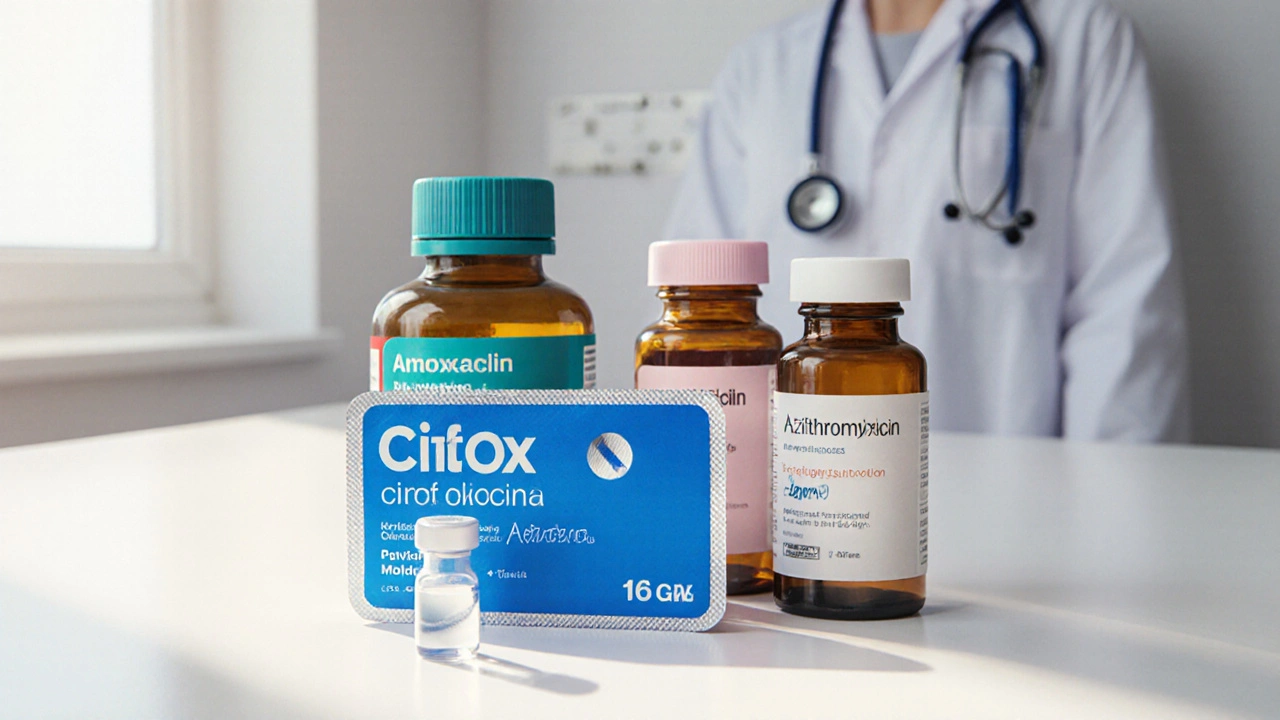Antibiotic Choice Guide: Ciplox vs Alternatives
Ciplox (Ciprofloxacin)
High Risk Broad-spectrum fluoroquinolone. Effective against many bacteria but with potential tendon and nerve risks.
Amoxicillin
Low Risk Safe, affordable penicillin antibiotic for common infections.
Levofloxacin
Moderate Risk Similar to Ciplox but potentially safer for short-term use.
Azithromycin
Low-Moderate Risk Convenient once-daily macrolide for respiratory infections.
Compare Antibiotics
| Antibiotic | Class | Typical Uses | Dosing | Side Effects | Resistance |
|---|---|---|---|---|---|
| Ciprofloxacin (Ciplox) | Fluoroquinolone | UTI, gastroenteritis, skin infections | 500 mg PO BID 3–14 days | Tendon rupture, neuropathy, QT prolongation | Rising in community E. coli |
| Levofloxacin | Fluoroquinolone | Community-acquired pneumonia, chronic bronchitis | 750 mg PO daily 5–7 days | Similar to ciprofloxacin but less tendon risk | Moderate; still higher than beta-lactams |
| Amoxicillin | Penicillin (beta-lactam) | Sinusitis, otitis media, streptococcal pharyngitis | 500 mg PO TID 7–10 days | Rash, mild GI upset | Low; many strains remain susceptible |
| Azithromycin | Macrolide | Atypical pneumonia, chlamydia, gonorrhea | 500 mg PO day 1 then 250 mg daily 4 days | Diarrhoea, mild QT prolongation | Increasing in some respiratory pathogens |
| Doxycycline | Tetracycline | Lyme disease, acne, chlamydia | 100 mg PO BID 7–14 days | Photosensitivity, esophagitis | Low; resistance rare in indicated uses |
Decision Factors
Consider these factors when choosing an antibiotic:
- Infection Type: Match antibiotic to the type of bacteria causing the illness.
- Risk Factors: Age >60, steroid use, or tendon issues may make fluoroquinolones less suitable.
- Severity: Severe or deep tissue infections may require broad-spectrum agents.
- Local Resistance Patterns: In some areas, resistance to Ciplox is increasing.
- Drug Interactions: Some antibiotics interact with warfarin, antacids, or diabetic medications.
ciprofloxacin is the drug most people think of when they hear "Ciplox." But not everyone can or wants to use it, and there are plenty of other antibiotics that might fit better. Below you’ll see a quick‑hit list, a clear breakdown of Ciplox, and a side‑by‑side look at the top rivals.
Quick Takeaways
- Ciplox belongs to the fluoroquinolone class, which targets a broad range of bacteria but carries a higher risk of tendon and nerve issues.
- Levofloxacin offers similar coverage with a slightly better safety profile for short courses.
- Amoxicillin is a go‑to for many community infections and has the lowest side‑effect burden.
- Azithromycin works well for atypical respiratory bugs and has a convenient once‑daily dosing.
- Choosing the right drug depends on infection type, local resistance patterns and personal health factors.
What is Ciplox (Ciprofloxacin)?
Ciprofloxacin is a synthetic fluoroquinolone antibiotic that interferes with bacterial DNA replication. It’s sold under the brand name Ciplox in Australia and many other markets. First approved in 1987, it’s been a workhorse for treating urinary tract infections (UTIs), gastrointestinal infections, and certain skin conditions.
How does Ciplox work?
The drug blocks two key bacterial enzymes-DNA gyrase and topoisomerase IV. Without these enzymes, bacteria can’t unwind their DNA to copy it, so they die. This mechanism gives Ciplox a broad spectrum, covering Gram‑negative bugs like Escherichia coli and some Gram‑positive organisms.
Typical uses and dosage
In Australia, the most common prescriptions are:
- Uncomplicated UTI: 500mg twice daily for 3days.
- Acute bacterial prostatitis: 500mg twice daily for 10‑14days.
- Travel‑related diarrhoea (often caused by Campylobacter or Shigella): 500mg twice daily for 3days.
Capsules and oral suspension are the standard forms, while an IV version exists for hospital use.
Pros and cons of Ciplox
Pros
- Broad‑spectrum coverage makes it useful for mixed‑infection scenarios.
- Good oral bioavailability-often no need for IV switch.
- Relatively inexpensive compared with newer agents.
Cons
- Risk of tendon rupture, especially in people over 60 or those on steroids.
- Can cause peripheral neuropathy, which may be irreversible.
- Increasing resistance in community‑acquired E.coli strains.
- Not recommended for pregnant or breastfeeding women.
Top alternatives to Ciplox
If Ciplox isn’t a good fit, doctors often turn to one of these options:
- Levofloxacin - another fluoroquinolone but with a slightly milder side‑effect profile for short courses.
- Norfloxacin - similar to Ciprofloxacin but mainly used for UTIs and prostatitis.
- Amoxicillin - a beta‑lactam antibiotic with excellent safety; works well for many respiratory and ear infections.
- Azithromycin - a macrolide that’s great for atypical pneumonia and some sexually transmitted infections.
- Doxycycline - a tetracycline useful for tick‑borne diseases, acne, and certain STIs.

Side‑by‑side comparison
| Antibiotic | Class | Typical infections | Common dosing (adult) | Main side‑effects | Resistance concerns |
|---|---|---|---|---|---|
| Ciprofloxacin (Ciplox) | Fluoroquinolone | UTI, gastroenteritis, skin infections | 500mg PO BID 3‑14days | Tendon rupture, neuropathy, QT prolongation | Rising in community E.coli |
| Levofloxacin | Fluoroquinolone | Community‑acquired pneumonia, chronic bronchitis | 750mg PO daily 5‑7days | Similar to ciprofloxacin but less tendon risk | Moderate; still higher than beta‑lactams |
| Amoxicillin | Penicillin (beta‑lactam) | Sinusitis, otitis media, streptococcal pharyngitis | 500mg PO TID 7‑10days | Rash, mild GI upset | Low; many strains remain susceptible |
| Azithromycin | Macrolide | Atypical pneumonia, chlamydia, gonorrhea | 500mg PO day1 then 250mg daily 4days | Diarrhoea, mild QT prolongation | Increasing in some respiratory pathogens |
| Doxycycline | Tetracycline | Lyme disease, acne, chlamydia | 100mg PO BID 7‑14days | Photosensitivity, esophagitis | Low; resistance rare in indicated uses |
How to pick the right antibiotic
Ask yourself these quick questions before a doctor writes a script:
- What bug am I fighting? Lab‑confirmed bacteria usually steer you toward a narrow‑spectrum drug.
- Do I have any risk factors? Age>60, steroid use, or a history of tendon problems make fluoroquinolones less attractive.
- Is the infection serious or complicated? For deep‑tissue or hospital‑acquired infections, a broad agent like Ciplox might be justified.
- What does my local resistance map look like? In Queensland, primary‑care doctors see rising ciprofloxacin resistance in E.coli urine isolates, so they often start with amoxicillin‑clavulanate instead.
- Are there drug interactions? Fluoroquinolones can affect warfarin, antacids and certain diabetic meds.
Talking these points through with your GP can shrink the chance of an unnecessary prescription.
Safety tips and red flags
- Stop the drug immediately if you feel sudden joint pain, swelling or a tingling sensation in your feet.
- Never mix Ciplox with calcium‑rich antacids within two hours of each dose; absorption drops dramatically.
- Stay hydrated-this helps kidneys clear the drug and reduces crystal formation in the urine.
- If you’re pregnant, ask for a safer alternative like amoxicillin; ciprofloxacin crosses the placenta.
Frequently Asked Questions
Can I use Ciplox for a cold?
No. Colds are viral, and Ciplox only works on bacteria. Taking it won’t make you feel better and may increase resistance.
How long does it take for Ciplox to clear a UTI?
Most people feel relief within 24‑48hours, but the full course (often three days) should be finished to prevent relapse.
Is it safe to take Ciplox with alcohol?
There’s no direct interaction, but alcohol can irritate the stomach and increase the risk of nausea, which Ciplox already can cause.
What should I do if I miss a dose?
Take the missed tablet as soon as you remember, unless it’s almost time for the next dose. In that case, skip the missed one-don’t double‑dose.
Are fluoroquinolones like Ciplox still first‑line for infections?
Guidelines have shifted. They’re reserved for cases where narrower antibiotics fail or when the infection is severe and the bug is known to be sensitive.
Bottom line: Ciplox packs a powerful punch, but that power comes with real risks. Weigh those against the infection you’re treating, and consider the safer, often cheaper alternatives listed above. A quick chat with your doctor-armed with these points-will usually land you on the right choice.





Michelle Abbott
October 8, 2025 AT 18:44The pharmacodynamic profile of ciprofloxacin is presented superficially; a rigorous analysis would reference the AUC/MIC thresholds that dictate bactericidal activity, especially in the context of resistant Enterobacteriaceae strains. Moreover, the discussion neglects the impact of renal clearance variability on dosing regimens, which is pivotal for avoiding sub-therapeutic exposure. The risk matrix should also integrate the FDA’s black-box warnings concerning tendonopathy and neurotoxicity, not merely a cursory mention. Finally, the comparative table omits the cost‑effectiveness evaluation, a factor that influences formulary decisions in most institutions.
Akshay Pure
October 15, 2025 AT 17:24While your points attempt brevity, they betray a shallow engagement with the underlying microbiological complexities. The AUC/MIC ratio is not a trivial statistic; it is the cornerstone of dose optimisation for fluoroquinolones, as substantiated by contemporary CLSI guidelines. Neglecting renal function variability undermines therapeutic efficacy, especially in geriatric cohorts where creatinine clearance fluctuates dramatically. Your omission of health‑economic considerations reflects a paucity of holistic clinical judgement, which may misguide prescribers seeking balanced therapeutic pathways.
Heather Jackson
October 22, 2025 AT 16:04Wow this is like a rollercoaster of info! So many meds and the tables are sooo helpful, but i cant help but feel a lil overwhelmed. The way u broke down the risks is pretty dramatic – like "tendon rupture" sounds scary af! Hopefully docs read this and pick the safe route, lol.
Matt Stone
October 29, 2025 AT 14:44Ciplox is overprescribed stop it.
Doug Farley
November 5, 2025 AT 13:24Oh sure, because a one‑sentence manifesto solves the global antimicrobial resistance crisis. Maybe next you’ll suggest we just ban antibiotics entirely and let infections run wild. Real helpful, thanks for the deep insight.
Steven Macy
November 12, 2025 AT 12:04When navigating the labyrinth of antibiotic selection, it is useful to step back and consider the broader clinical landscape. The decision matrix should begin with a precise identification of the pathogen whenever possible, as empirical therapy is a bridge, not a destination. Broad‑spectrum agents like ciprofloxacin wield considerable power, yet that power carries the responsibility of judicious use to forestall resistance cycles.
For patients over sixty or those on chronic corticosteroids, the tendon‑toxicity risk escalates, urging clinicians toward narrower agents whenever culture data permit. Moreover, the intersection of drug‑drug interactions – particularly with warfarin or certain antidiabetics – demands meticulous reconciliation to prevent iatrogenic complications.
From a pharmacokinetic standpoint, fluoroquinolones achieve excellent oral bioavailability, reducing the need for intravenous transitions, but this convenience must be weighed against the propensity for QT prolongation in susceptible cardiac patients.
Local antibiograms are invaluable; they illuminate regional resistance patterns that may render ciprofloxacin suboptimal in urinary isolates where ESBL-producing E. coli dominate.
Conversely, amoxicillin‑clavulanate often retains activity against such strains, offering a safer β‑lactam alternative with a markedly lower adverse‑event profile.
When respiratory infections are the target, azithromycin’s once‑daily dosing enhances adherence, though its macrolide‑mediated arrhythmogenic potential cannot be ignored.
Doxycycline, with its anti‑inflammatory properties, may be preferential in tick‑borne diseases, yet photosensitivity remains a counseling point for sun‑exposed patients.
Ultimately, shared decision‑making should involve a candid discussion of these trade‑offs, empowering patients to weigh efficacy against safety, cost, and convenience.
In the end, antibiotics are tools, not panaceas; their optimal deployment hinges on precise diagnosis, patient‑specific risk stratification, and vigilant stewardship.
Joy Luca
November 19, 2025 AT 10:44Just a quick note on some minor grammar points: the phrase "high risk broad-spectrum" should be hyphenated as "high‑risk broad‑spectrum" for clarity. Also, "risk badge" could be capitalized if it’s a heading. Remember to keep consistent punctuation; the list items sometimes end without a period but sometimes with one – pick one style and stick to it. Lastly, "ciprofloxacin" is a proper noun for the drug name, so it can be capitalized in titles if you prefer consistency across the document.
Jessica Martins
November 26, 2025 AT 09:24Corrected: "High‑risk broad‑spectrum" and consistent period usage. Looks good now.
Jeremy Olson
December 3, 2025 AT 08:04From a formal perspective, the article successfully synthesizes a wealth of data into a usable comparison chart, yet it would benefit from a concise executive summary highlighting the key decision criteria for clinicians with limited time.